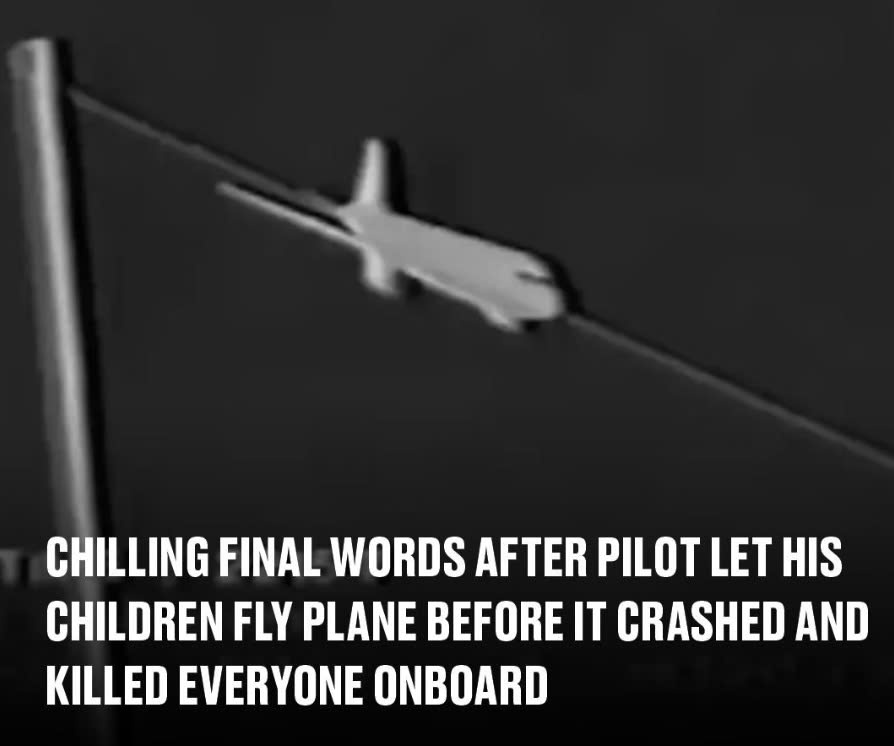A heartbreaking aviation disaster unfolded on March 23, 1994, when Aeroflot Flight 593 crashed while flying from Moscow to Hong Kong, killing all 75 passengers and crew members on board. The crash remains one of the most devastating and preventable tragedies in aviation history. What makes this incident especially haunting is the reason behind it—a decision made by one of the pilots to let his children sit in the cockpit and interact with the plane’s controls, a choice that set off a deadly chain of events.

The flight departed late at night with a highly experienced crew in command. Captain Andrey Viktorovich Danilov had logged over 9,500 hours of flight time. Alongside him were First Officer Igor Vasilyevich Piskaryov and Relief Captain Yaroslav Vladimirovich Kudrinsky, both seasoned aviators in their own right. Despite their expertise, none of them could foresee that allowing children into the cockpit would lead to the plane’s downfall.
For Kudrinsky’s two children—13-year-old Yana and 15-year-old Eldar—this was their first international trip. Hoping to make it special, Kudrinsky invited them into the cockpit during the flight. While aviation regulations strictly forbid this kind of behavior, the crew believed that the autopilot would manage the aircraft safely, even if the children playfully touched the controls. They assumed the controls wouldn’t respond under autopilot and that no harm could come from it.
At around 12:43 a.m., Yana was the first to sit in the captain’s seat. She pretended to steer the plane, and all seemed well. A few minutes later, Eldar took his turn. While sitting in the pilot’s seat, Eldar was allowed to move the control stick. Again, the assumption was that autopilot would keep the aircraft steady, regardless of any input from the child.
But things began to go wrong quickly. By 12:54 a.m., Eldar had been handling the controls for over 30 seconds, applying pressure up to 10 kilograms. This unintentional force disrupted the autopilot system, which quietly switched the aircraft from automatic to manual mode without the crew noticing. A small indicator light flashed, signaling the switch, but because the crew was unfamiliar with the Western-built Airbus A310 and its alert systems, they didn’t catch the critical warning.
@onlythemostviral This is a reconstruction of Aeroflot Flight 193, all of this data was recovered in the black box. No evidence of a technical malfunction was found. Cockpit voice and flight data recorders revealed the presence of the relief captain’s 13-year-old daughter and 15-year-old son in the cockpit. While seated at the controls, the pilot’s son had unknowingly partially disengaged the A310’s autopilot control of the aircraft’s ailerons. The autopilot then disengaged completely, causing the aircraft to roll into a steep bank and a near-vertical dive. Despite managing to level the aircraft, the first officer over-corrected when pulling up, causing the plane to stall and enter into a spin; the pilots managed to level the aircraft off once more, but the plane had descended beyond a safe altitude to initiate a recovery and subsequently crashed into the mountain range. All 75 occupants died on impact. #planecrash #plane #viral #emergency #airemergency #aviationlovers #aviationlife #aviationdaily #crash #aeroflot #aeroflot593 #aeroflotcrash #aviationtiktok #emergencylanding #emergencyintercom #accident #russia #россия #россия🇷🇺 #аеропорт #прикол ♬ original sound – Only The Most Viral
As the aircraft began to slowly bank to the right, it went unnoticed until it was already in a compromised position. With autopilot disengaged and no manual correction made, the aircraft could no longer maintain proper altitude or balance. Captain Kudrinsky quickly realized the danger and told his son to leave the seat so the pilots could regain control. His voice, captured by the cockpit voice recorder, grew more desperate as he shouted, “Eldar, get away. Go to the back, go to the back, Eldar! You see the danger, don’t you?” He continued pleading, “Go away, go away, Eldar! Go away, go away. I tell you to go away!”
The pilots struggled to stabilize the aircraft. They nearly managed to level it, but unfortunately, they overcorrected, and the plane abruptly entered an almost vertical climb. That steep ascent caused the aircraft to stall, losing lift and entering a deadly spin. The jet dropped rapidly, plunging below the minimum safe altitude as it passed over mountainous terrain.
By 12:58 a.m., the aircraft was in free fall. Just one minute later, at 12:59 a.m., air traffic controllers in Novokuznetsk waited for a scheduled update from the flight. That message never came. The plane had vanished from radar. Moments earlier, it had slammed into the Kuznetsk Alatau Mountains in the Kemerovo region of southern Russia at a speed of around 160 miles per hour. The aircraft was destroyed on impact.
All 75 people on board were killed instantly. Initially, Aeroflot denied any wrongdoing by the crew. However, a thorough investigation, supported by cockpit recordings, revealed the devastating truth: human error was the primary cause of the crash. Allowing children to access the controls, combined with the crew’s unfamiliarity with the plane’s systems, created a perfect storm that led to one of the most avoidable disasters in aviation history. This tragedy serves as a sobering reminder that in aviation, even the smallest breach of protocol can have fatal consequences.





